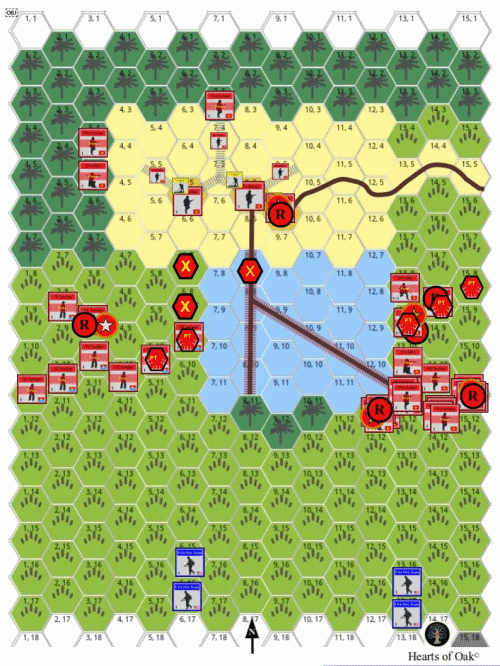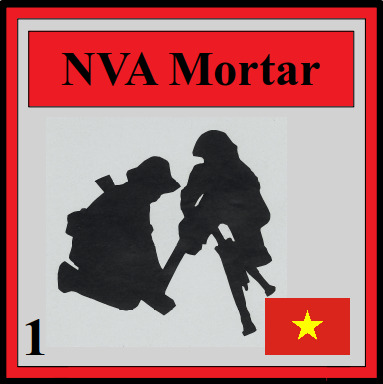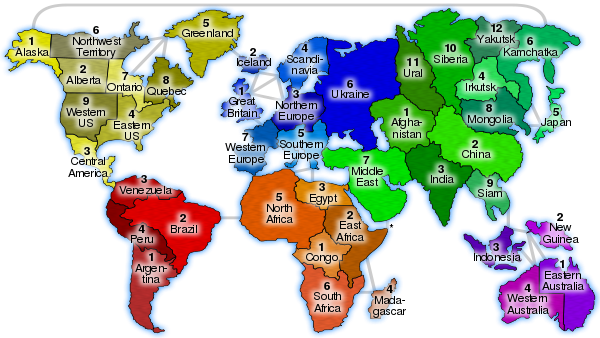Battle of Tuyệt Quá HởTấn After Action Report
From about July 2021 until June 2022 I played “Battle of Tuyệt Quá HởTấn”, one of the “Section by Section” games by Hearts of Oak. This was played online over WhatsApp and Google Slides.
The setting is a small village during the Vietnam War. Both the Viet Cong and North Vietnamese Army are defending the civilians in the village, with American soldiers coming to interrogate them using four platoons from two companies. That’s about 200 hundred soldiers on each side. Before any pieces are placed on the virtual board, the game looks like the image below. The village to the North of the map, the darkest green is jungle, the light green is brush, the blue is paddy fields.

Before the troops arrive.
Orders were issued over WhatsApp, with a dedicated group conversation for each side. The “board” was on Google slides, but on two separate sets of slides. Each side was only given access to the slides showing their own troops, with only the game runner having access to both. There were detailed spotting rules in place, so unlike many wargames, blue couldn’t see all of red, and red couldn’t see all of blue. This made the game much more realistic, and made trying to be undetected a significant part of the gameplay. A gif showing where my troops were - I was playing the VC and NVA in red - was created by the game runner at the end of the event, and is shown below:

Blue advances, looks dominant, but then flies away leaving the village untouched.
While the moves and decisions made were interesting, what really got me thinking about the game was the format. And I should stress that while I’ve listed some criticisms below I really enjoyed taking part, and I’ve found the experience really thought provoking - particularly to help clarify some of my views about the function and use of games in general.
Firstly, any wargame that has a “purple” board, that being a board where both red and blue have a “god’s eye view”, is sub-optimal, and should be the last choice not the first choice. Running games with multiple boards is difficult in any medium, but even more so for physical or “manual” games; at least you can copy and paste the pieces and their positions on a virtual board. But, the gain from running multiple boards is so great - giving players an opportunity to experience the ubiquitous “fog of war”, and also showing the players how much thought is required in preparing for the many different locations where an adversary might be.
Similarly, any wargame that has the players in direct communication with each other is less than ideal. Again, this is particularly difficult with physical boards and pieces, but having your only communication with your enemy being attacks and retreats and volleys of fire can really illustrate the lack of information in genuine conflicts. For me that makes this kind of game much more interesting, and from limited comparisons makes historic military decision making make a lot more sense.
To cite an example from this particular game, I spent little attention on my mortar team. I used them to aim at what enemy units I could see, then at the opposing mortar as “counter battery fire”, and also at casualties being picked up. During the game I thought, at best, they were being annoying to the enemy and at least giving them something else to think about. But from my opponent’s report written at the end of the game, in the section on indirect fire: “Liked the additional supportive firepower and potential scatter of artillery strikes . Made you think about how close your troops were to your own artillery bombardments. Was not in charge of mortars but felt the VC mortar team were very effective.”

My mortar team.
Similarly being unable to engage with the opposing players over a board or tabletop means that, on the larger scale, you also have an imperfect idea of how the game is progressing. For example, towards the end of this battle my Vietnamese forces were preparing to be over-run, and those units loitering in the jungle were at risk of taking another artillery strike. So as the American troops withdrew slightly from the edge of the jungle, I brought my troops out as one last ditch defense; a poor option, but better than waiting to be hit by artillery or another bombing run in their current position…
…instead of the intense firefight I was expecting, the American units kept withdrawing, and suddenly they flew in a squadron of helicopters to evacuate their troops. To the American players this looked like I was following the Viet Cong tactic of “grab the enemy’s belt”, staying too close to your enemy for them to risk hitting their own troops with artillery or bombers. In the discussion afterwards the opposing players were impressed by my tenacious and brave approach. But as I remember it - this was much more a last chance for my troops to inflict casualties, and made with an assumption that an artillery or air raid was about to hit the position. It’s this clash of narratives that you can only have with dedicated red and blue boards, and no in-game communication with your opponents; and, most importantly, a post game debrief.
But while enjoying all these hidden aspects of the game, I think ideally this game would go one step further. The game was “IGOUGO”, meaning that the sides took alternate moves. While relatively unrealistic, this is far, far easier to manage in a game than the method called “WEGO”, where all moves are simultaneous. Especially for a board game WEGO is particular hard to resolve. And in this case the game runner was kindly reading written orders, carrying them all out, and describing the results - a “WEGO” system would have increased this workload.
Taking my thoughts even further, squares model movement inaccurately, so games tend to use gexes, but I also dislike hexes, even though hexagons are the bestagons . In this case they worked well enough, but I still find it perturbing that forces can’t do something as simple as move sideways. For me I think the ideal solution is either free movement, or some depiction of zones or areas on a map… but again I’m being idealistic, even creating a map with zones is a far more onerous task than using squares or hexes.

The popular game Risk is maybe the most obvious game that uses areas.
I have always been intrigued by games, but I’m increasingly aware I like to design or explore them more than play them, and I’m beyond that I’m increasingly comfortable with exploring the more challenging concepts like WEGO, and separate boards for each player. I also increasingly see my future in game design. I think there’s a lot to learn from them and from playing them.
From a game playing and game design point of view I think these are relatively strong, and relatively rare, opinions. I recall reading the manifestos of particular artistic groups, on what or wasn’t not acceptable if you were to part of their scene. I wonder if I ought to write up my personal one for game design? Of course, this is for myself and my aims; I love the variety of games, and the variety of people that play them, I’m finally figuring out where I fit into that range.
One last point - Ian at Hearts of Oak set up a Gather Town for the post-game debrief. While we didn’t wander around the map much in the end, with some jungle background noises discussing the game in this virtual location was a great way to debrief and discuss.

The setting for the debrief.
If all the detail of the game, or an opportunity to play, goes online I’ll update this post.
